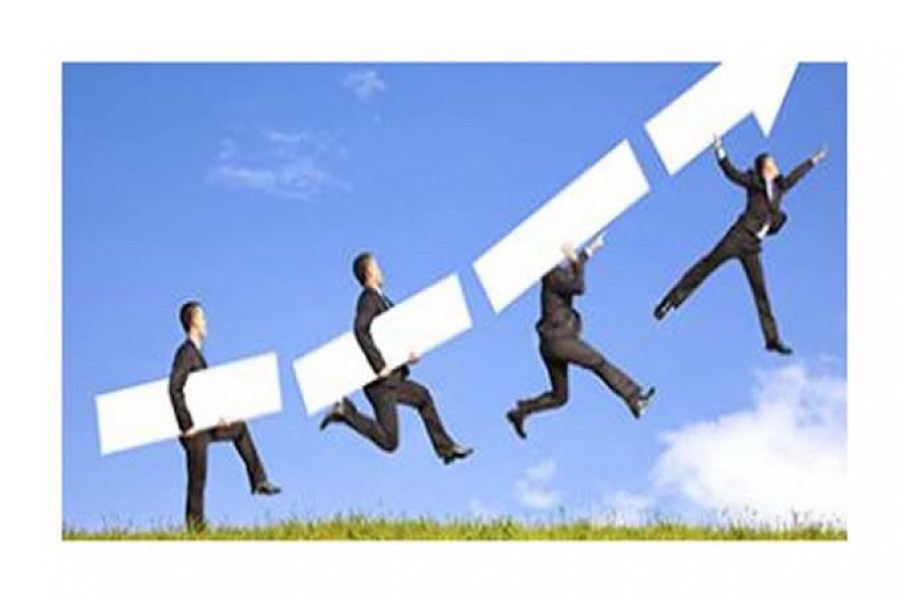One-fourth or 25 per cent of the total population of Bangtladesh may belong to the middle class income category by 2025, thanks to greater access to education, finance and information technology (IT) services and private sector employment, says a recent study.
At present, 20 per cent of the population belongs to the middle-income category in Bangladesh in contrast to 24.1 per cent in neighbouring India. If the present trend continues, the middle class will comprise one-third or 33 per cent of the national population in 2030, said a research study of the Bangladesh Institute of Development Studies (BIDS).
In 1992, only 09 per cent of the national population belonged to the middle-class category. The number increased to 20 per cent in 2010. The growth of middle-class has been driven by human capital accumulation and property price appreciation. Human capital accumulation means more people now pass post-secondary or higher levels of education.
Access to post-secondary education, especially English education, salaried jobs in the private sector, digital divide, access to financial saving and credit instruments, access to international migration and land or flat ownership appear to be separating the middle-class from the poor.
According to the findings of the study, 48.4 per cent of the middle-class population is employed in the private sector and 20.4 per cent in the public sector. Of the middle-class population, 61.3 per cent has internet connection at home, 49 per cent owns land in urban areas, 33 per cent owns flat and 31 per cent has earnings in the form of house or flat rent.
Describing the middle-class as a good component for inclusive growth, the study says countries with higher middle-class density are able to reduce poverty faster than those with lower density.
What is important, says the planning minister at a recent meeting, is that the middle-class will be the driving force behind economic development. By strengthening the middle-class, a sustainable development is possible, he added.
There is no denying the fact that the middle class community acquired self-identity through education in the past. However, currently education is not that important for earning money, and against that backdrop, self-identity is also getting reduced.
The growth of the middle class is phenomenal in the country. Another recent study on 'Faltering middle class aspirations in Bangladesh' signifies that a growing number of Bangladeshis have been able to achieve a middle class consumer lifestyle over the years, driving the foreign direct investment (FDI) in the consumer goods market.
Expansion in services, especially the retail, financial and public administration sectors, is responsible for the growth of middle class. The sectors grew between 8.0 per cent and 13 per cent leading to the creation of more jobs for the middle class.
The socio-economic changes that broadly explain the emergence of the middle class are increasing incomes, urbanisation, white-collar occupations fuelling the demand for consumer products and services. Government policies and the nature and level of spending have also influenced the pace of the middle class growth.
Middle class people want to lead their lives with dignity and that is why they give importance to housing and education first and then to food, medical treatment and transportation. After spending lion's share of their income on these, they cannot meet the other demands with the amount left. This remains a big problem for them.
Frustration is growing among these groups, as neither their income has increased nor they are getting any support from the government's safety net programmes for the poor. Besides, house rent, cost of education and medical treatment and transport charges are also on a steady rise while the income of these groups remained static, making it harder for them to make ends meet. A large section of them are showing signs of being incapable of dealing with the sudden price hike of essentials.
The soaring prices of essentials have also pushed up the house rents in Dhaka and other major cities. A lowly-placed middle income employee can't afford to give rickshaw fare to his children anymore, even finds it difficult ot provide them snacks in the afternoon. He has to struggle hard to cope with the rising prices of essentials. He tries to supplement his income, but cannot. What can he do but endure silently?
Inflation is also on rise in the country and quickly burning a hole in the pockets of the general public. Almost everyone feels they are fighting a losing battle against prices. Rising prices create mounting stress.
At the present rate of the rising prices, a middle class family finds it very difficult to make ends meet. Commodity prices are rising. Utility bills too are on a hike. Prices of necessary food items such as rice, pulses, oil and green vegetables are becoming costlier every day.
Despite the difficult times the middle class is going through, there can be no denying that the middle class is a good component for inclusive growth and a key driver of sustainable development.


